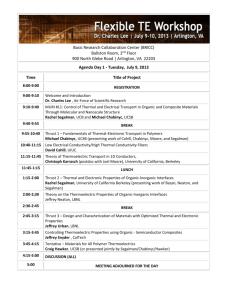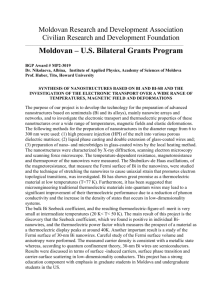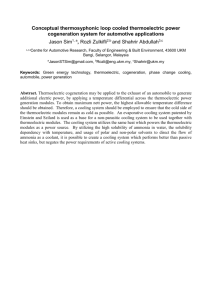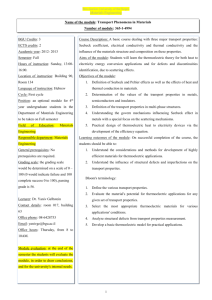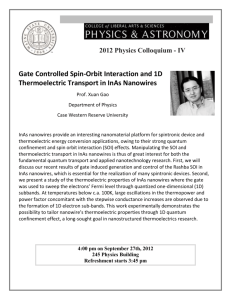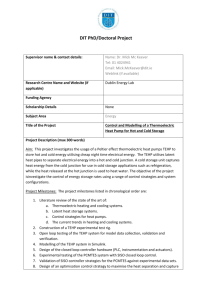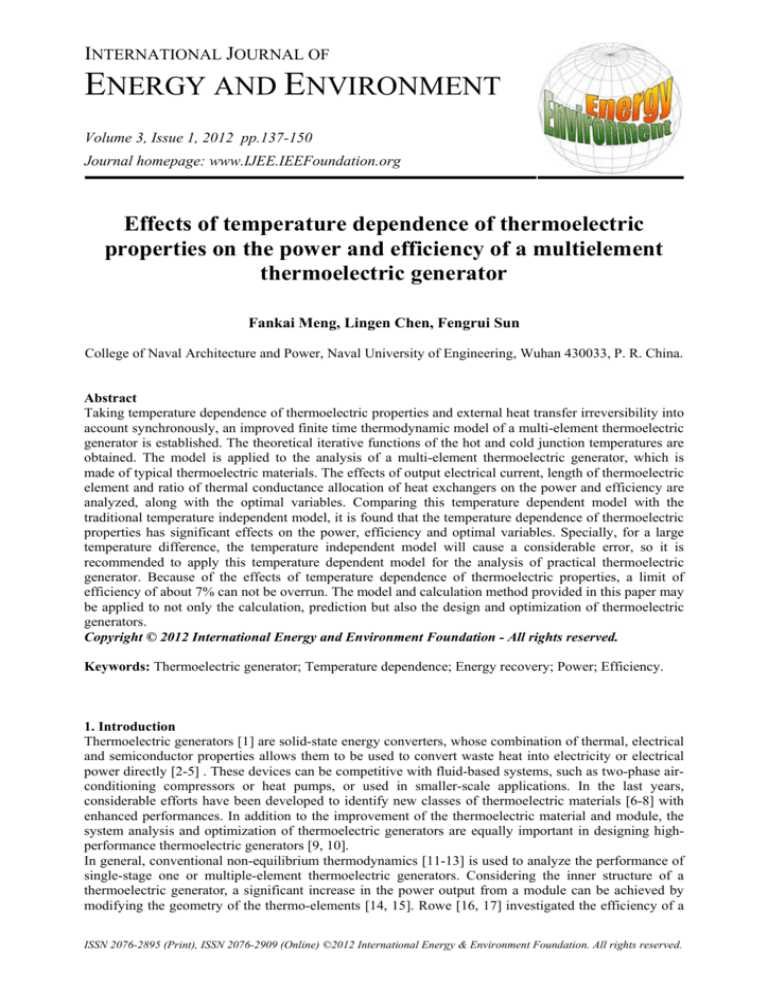
INTERNATIONAL JOURNAL OF
ENERGY AND ENVIRONMENT
Volume 3, Issue 1, 2012 pp.137-150
Journal homepage: www.IJEE.IEEFoundation.org
Effects of temperature dependence of thermoelectric
properties on the power and efficiency of a multielement
thermoelectric generator
Fankai Meng, Lingen Chen, Fengrui Sun
College of Naval Architecture and Power, Naval University of Engineering, Wuhan 430033, P. R. China.
Abstract
Taking temperature dependence of thermoelectric properties and external heat transfer irreversibility into
account synchronously, an improved finite time thermodynamic model of a multi-element thermoelectric
generator is established. The theoretical iterative functions of the hot and cold junction temperatures are
obtained. The model is applied to the analysis of a multi-element thermoelectric generator, which is
made of typical thermoelectric materials. The effects of output electrical current, length of thermoelectric
element and ratio of thermal conductance allocation of heat exchangers on the power and efficiency are
analyzed, along with the optimal variables. Comparing this temperature dependent model with the
traditional temperature independent model, it is found that the temperature dependence of thermoelectric
properties has significant effects on the power, efficiency and optimal variables. Specially, for a large
temperature difference, the temperature independent model will cause a considerable error, so it is
recommended to apply this temperature dependent model for the analysis of practical thermoelectric
generator. Because of the effects of temperature dependence of thermoelectric properties, a limit of
efficiency of about 7% can not be overrun. The model and calculation method provided in this paper may
be applied to not only the calculation, prediction but also the design and optimization of thermoelectric
generators.
Copyright © 2012 International Energy and Environment Foundation - All rights reserved.
Keywords: Thermoelectric generator; Temperature dependence; Energy recovery; Power; Efficiency.
1. Introduction
Thermoelectric generators [1] are solid-state energy converters, whose combination of thermal, electrical
and semiconductor properties allows them to be used to convert waste heat into electricity or electrical
power directly [2-5] . These devices can be competitive with fluid-based systems, such as two-phase airconditioning compressors or heat pumps, or used in smaller-scale applications. In the last years,
considerable efforts have been developed to identify new classes of thermoelectric materials [6-8] with
enhanced performances. In addition to the improvement of the thermoelectric material and module, the
system analysis and optimization of thermoelectric generators are equally important in designing highperformance thermoelectric generators [9, 10].
In general, conventional non-equilibrium thermodynamics [11-13] is used to analyze the performance of
single-stage one or multiple-element thermoelectric generators. Considering the inner structure of a
thermoelectric generator, a significant increase in the power output from a module can be achieved by
modifying the geometry of the thermo-elements [14, 15]. Rowe [16, 17] investigated the efficiency of a
ISSN 2076-2895 (Print), ISSN 2076-2909 (Online) ©2012 International Energy & Environment Foundation. All rights reserved.
138
International Journal of Energy and Environment (IJEE), Volume 3, Issue 1, 2012, pp.137-150
single couple solar powered thermoelectric generator and reviewed US applications of nuclear-powered
thermoelectric generators in space. Chen et al. [18] investigated the influence of Thomson effect on the
maximum power output and maximum efficiency of a thermoelectric generator. Yamashita [19] derived
the resultant Seebeck coefficient of a thermoelectric element analytically from the temperature
dependence of the intrinsic Seebeck coefficient by taking into account the Thomson effect.
Thermoelectric devices can not be used independently. They should be connected with heat exchangers
to dissipate heat [2-5]. Considering the external irreversibilities of a thermoelectric generator, much work
has shown that the heat transfer irreversibilities between the device and its external reservoirs affect the
performances of thermodynamic processes strongly. The theory of finite time thermodynamics or
entropy-generation minimization [20-26] is a powerful tool for the performance analysis and
optimization of practical thermodynamic processes and devices, especially for finite rate heat transfer.
Some authors have investigated the performances of thermoelectric generators using a combination of
finite time thermodynamics and non-equilibrium thermodynamics. Gordon [27], Wu [28], Agrawal et al.
[29], Chen et al. [30, 31] and Nuwayhid et al. [32] analyzed the effect of finite rate heat transfer between
the thermoelectric device and its external heat reservoirs on the performance of single-element
thermoelectric generators.
In practice, a commercial thermoelectric generator is a multielement device, which is composed of many
fundamental thermoelectric elements. Many researchers investigated the characteristics of multielement
thermoelectric generators with the irreversibility of external finite-rate heat transfer, Joulean heat inside
the thermoelectric device, and the heat leakage through the thermoelectric element. Chen et al. [33, 34]
analyzed the effects of external heat conductance and the number of elements on the power output and
efficiency of a multi-elements generator. Yu and Zhao [35] presented a numerical model to predict the
performance of thermoelectric generator with the parallel-plate heat exchanger. Niu et al. [36]
constructed an experimental thermoelectric generator unit incorporating the commercially available
thermoelectric modules with the parallel-plate heat exchanger. Hsiao et al. [37] built a one dimensional
thermal resistance model to predict the behavior of thermoelectric modules applied in exhaust and
radiator of an automobile. Chen [38], Khattab and Shenawy [39], and Meng et al. [40-43] investigated
the feasibility and performance optimization of a single (two) stage thermoelectric refrigerator or heat
pump driven by a single (two) stage thermoelectric generator. There is no research concerning
thermoelectric generator considering external heat transfer and temperature dependence of thermoelectric
properties synchronously in open literatures.
Taking temperature dependence of thermoelectric properties and external heat transfer irreversibilities
into account synchronously, a finite time thermodynamic model of multielement thermoelectric
generator is established in this paper, based on which, the power and efficiency of a practical
multielement thermoelectric generator are calculated at different temperature difference. The effects of
output electrical current, length of thermoelectric element and ratio of thermal conductance allocation of
the heat exchangers on the power and efficiency are analyzed, along with the optimal variables.
2. System modeling and energy equations
A multielement thermoelectric generator with external heat transfer is shown in Figure 1. A
thermoelectric generator consists of P-type and N-type semiconductor legs. A P-type and an N-type
semiconductor leg compose a thermoelectric element. The geometry structure of a thermoelectric
element is shown in Figure 2. The length and cross section area of a thermoelectric semiconductor leg are
L and A . The number of thermoelectric elements is N . The junctions of the thermoelectric elements are
fixed at a thermal conducting and electrical insulting ceramic plate. The area of the ceramic plate is Am .
The module packed density θ is defined as θ = 2 AN / Am [15].
The hot and cold junction temperatures are Th and Tc . The heat source and heat sink temperatures are TH
and TL . The heat flow rate absorbed from the heat source of the thermoelectric generator is QH . The heat
flow rate dissipated from the thermoelectric generator to the heat sink is QL . The heat flow rate through
the hot and cold junctions of the thermoelectric elements are Qh and Qc . It is assumed that the heat
transfers between the heat reservoirs and the thermoelectric generator are finite rate irreversible heat
transfer and obey Newtonian heat transfer law Q ∝ ∆T .
The electrical resistance of the P- and N- type semiconductor leg are R p and Rn . The output electrical
current and load resistance are I and RL .
ISSN 2076-2895 (Print), ISSN 2076-2909 (Online) ©2012 International Energy & Environment Foundation. All rights reserved.
International Journal of Energy and Environment (IJEE), Volume 3, Issue 1, 2012, pp.137-150
139
Figure 1. Schematic diagram of a multielement thermoelectric generator with external heat
Figure 2. The geometry structure of a thermoelectric element
For a well design thermal insulation packaging module, the heat leakage from the surrounding of the
elements and module can be neglected, so the heat transfer of the whole device can be treated as one
dimensional heat transfer. According to the non-equilibrium thermodynamics, the inner effects of the
thermoelectric elements include Seebeck effect, Fourier effect, Joule effect and Thomson effect. The
increment rate of inner energy of the infinitesimal is zero at steady-state. One can obtain the heat
conduction differential equations of P- and N-Type semiconductor legs as follows [1]
k p Ap
kn An
dTp2
dx
2
+ µpI
dTp
dx
+
I2
=0
σ p Ap
dTn2
dT
I2
− µn I n +
=0
2
dx σ n An
dx
(1)
(2)
where k p , σ p , µ p , Ap , L p , Tp and kn , σ n , µn , An , Ln , Tn are the thermal conductivity, electrical
conductivity, Thomson coefficient, cross section area, length and temperature of the P-type and N-type
semiconductor leg, respectively.
The temperature boundary conditions are;
Tp (0) = Tn (0) = Tc
(3)
ISSN 2076-2895 (Print), ISSN 2076-2909 (Online) ©2012 International Energy & Environment Foundation. All rights reserved.
International Journal of Energy and Environment (IJEE), Volume 3, Issue 1, 2012, pp.137-150
140
Tp ( Lp ) = Tn ( Ln ) = Th
(4)
Taking effect of temperature dependence of thermoelectric properties into account, k p , σ p and µ p are
functions of Tp ; while kn , σ n and µ n are functions of Tn . However, such a differential equation can not
be solved theoretically. Replacing k , σ and µ with the mean value k , σ and µ approximately gives
approximations of Eqs. (1) and (2) as follows;
k p Ap
kn An
dTp2
dx
2
+ µpI
dTp
dx
+
I2
=0
σ p Ap
(5)
dTn2
dTn
I2
µ
−
+
=0
I
n
dx σ n An
dx 2
where k p ≈ k p
T = (Th + Tc )/ 2
(6)
, σp ≈σp
T = (Th + Tc )/ 2
, and µ p ≈ µ p
T = (Th + Tc )/ 2
for P-type semiconductor leg and for N-
type likewise. The total heat flow rates through the hot and cold junctions are;
⎛
dTp
Qh = N ⎜ (α ph − α nh )Th I + k p Ap
⎜
dx
⎝
⎛
dTp
Qc = N ⎜ (α pc − α nc )Tc I + k p Ap
⎜
dx
⎝
+ kn An
x = Lp
+ kn An
x =0
dTn
dx
dTn
dx
x = Ln
⎞
⎟
⎟
⎠
⎞
⎟⎟
x =0 ⎠
(7)
(8)
where α p and α n are the Seebeck coefficients of the P- and N- type semiconductor leg, and the
subscripts h and c represent the hot and cold sides.
It is assumed that the external thermal conductances at hot and cold sides are K H and K L , respectively.
Then one has;
QH = K H (TH − Th )
(9)
QL = K L (Tc − TL )
(10)
The heat flow balance equations are;
QH = Qh
(11)
QL = Qc
(12)
3. Solution of the model
The temperature distributions of the P- and N- type semiconductor legs can be solved by Eqs. (5) and (6)
as follows;
Tp ( x) = Tc − Fp x +
Tn ( x) = Tc + Fn x +
Th − Tc + Fp L p
(e
−ω p L p
)
−1
Th − Tc − Fn Ln
(
)
eωn Ln − 1
(e
−ω p x
− 1)
(eωn x − 1)
(13)
(14)
where ω p = µ p I / (k p Ap ) , Fp = I / (σ p µ p A) , ωn = µn I / (kn An ) and Fn = I / (σ n µn A) .
ISSN 2076-2895 (Print), ISSN 2076-2909 (Online) ©2012 International Energy & Environment Foundation. All rights reserved.
International Journal of Energy and Environment (IJEE), Volume 3, Issue 1, 2012, pp.137-150
141
For maximum figure of merit of the thermoelectric element Z = α 2 / ( KR) , the physical dimension of the
thermoelectric element and the physical property of the material should satisfy the following equation [1,
2].
Ap2 L2n
2 2
n p
AL
=
knσ n
k pσ p
(15)
To reduce the cost of manufacture, the P- and N- type semiconductor legs are made with same physical
dimensions in general, i.e. Ap = An = A and Lp = Ln = L . So one has k σ N / (k σ P ) = 1 by Eq. (15). Similar
doped alloys are adopted to make P- and N- type semiconductor legs. That is, σ p = σ n = σ , k p = kn = k ,
N
P
α p = −α n , and µ p = − µn . According to Taylor’s expension formula, when x 1 , e x ≈ 1 + x holds truly.
Based on the assumptions mentioned above, Eqs. (7) and (8) can be approximated as follows in the case
of µ I / K 1 :
Qh = N [α h ITh + K (Th − Tc ) − 0.5 I 2 R − 0.5µ I (Th − Tc )]
(16)
Qc = N [α c ITc + K (Th − Tc ) + 0.5I 2 R + 0.5µ I (Th − Tc )]
(17)
where α h = α hp − α hn and α c = α cp − α cn are the Seebeck coefficients of the thermoelectric elements at hot
and cold sides. µ = µ p − µn = 2µ p , K and R are the total Thomson coefficient, thermal conductance and
electrical resistance of a thermoelectric element. α IT , K ∆T , I 2 R and µ I ∆T are the rates of Peltier heat,
Fourier heat, Joule heat and Thomson heat, respectively. K and R are given by;
K = K p + K n = k p Ap / L p + kn An / Ln = 2k A / L
(18)
R = R p + Rn = L p / (σ p Ap ) + Ln / (σ n An ) = 2 L / (σ A)
(19)
The output power is given by;
P = Qh − Qc = NI [α h Th − α c Tc − IR − µ (Th − Tc )]
(20)
The contact resistance is also considered in this paper. The contact resistance is in proportion to the
reciprocal of the contact area with same manufacture and same thickness of the contact zone [1]. That is,
Rct = Cct / A , where Cct is a constant independent of the length of the thermoelectric element and A is the
cross area of a semiconductor leg.
Taking the Joule heat generated by the contact resistance as the thermoelectric elements generated and
replacing R with Rt = R + Rcu give the modified output power as follows;
P = Qh − Qc = NI [α h Th − α c Tc − IRt − µ (Th − Tc )]
(21)
The efficiency η = P / QH is given by;
η=
NI [α h Th − α c Tc − IRt − µ (Th − Tc )]
N [α h ITh + K (Th − Tc ) − 0.5 I 2 Rt − 0.5µ I (Th − Tc )]
(22)
Note that not only the temperature dependence of thermoelectric properties but also the external heat
transfer is considered in this paper. For given heat source and heat sink temperatures TH and TL , the
junction temperatures of thermoelectric element Th and Tc are unknown, thus the thermoelectric
properties α h , α c , k and σ and µ are unknown. Alteration method is adopted herein to determine the
ISSN 2076-2895 (Print), ISSN 2076-2909 (Online) ©2012 International Energy & Environment Foundation. All rights reserved.
142
International Journal of Energy and Environment (IJEE), Volume 3, Issue 1, 2012, pp.137-150
junction temperatures Th and Tc . The alteration formula can be solved by Eqs. (11) and (12) as follows;
N 2 Rt α c I 3 + (−2 N 2 Rt K − NRt K L ) I 2
+[2 Nα c K H TH + ( NK L TL − K H TH N ) µ ]I
Th =
−2 K H TH NK − 2 NKK L TL − 2 K L K H TH
[2 N 2α h α c − ( N 2α c + N 2α h ) µ ]I 2 − [2 N 2α h K
(23)
+ ( K H N − NK L ) µ − 2 K H Nα c + 2 Nα h K L − 2 N 2 Kα c ]I
−2 K H NK − 2 NKK L − 2 K H K L
N 2α h I 3 Rt + (2 N 2 Rt K + K H NRt ) I 2
+[(− NK L TL + K H TH N ) µ + 2 Nα h K L TL ]I
Tc =
+2 K H TH NK + 2 K H K L TL + 2 NKK L TL
[−2 N 2α h α c + ( N 2α c + N 2α h ) µ ]I 2 + [2 N 2α h K
(24)
+( K H N − NK L ) µ − 2 K H Nα c + 2 Nα h K L − 2 N 2 K α c ]I
+2 K H NK + 2 NKK L + 2 K H K L
where α h , α c , K , Rt and µ are functions of Th and Tc . For given initial values of Th and Tc
( Th = TH , Tc = TL , for example), α h , α c , K , Rt and µ can be calculated by the fitting equation of the
thermoelectric material. Then Th and Tc can be calculated by Eqs. (23) and (24). Repeating the process
until required precision is obtained.
If the temperature dependence of thermoelectric properties is not considered, the model changes into a
temperature independent model, and then Eqs.(16) and (17) change into;
Qh = N [α ITh + K (Th − Tc ) − 0.5I 2 R]
(25)
Qc = N [α ITc + K (Th − Tc ) + 0.5 I 2 R ]
(26)
Eqs. (23) and (24) change into [27, 28, 31, 33, 34, 37].
0.5 N 2 Rt α I 3 + (− N 2 Rt K − 0.5 NRt K L ) I 2
Th =
+ Nα K H TH I − NK ( K H TH + K L TL ) − K L K H TH
N 2α 2 I 2 + N α ( K H − K L ) I
(27)
− NK ( K H + K L ) − K H K L
0.5 N 2α I 3 Rt + ( N 2 Rt K + 0.5 NRt K H ) I 2
Tc =
+ Nα K L TL I + NK ( K H TH + K L TL ) + K H K L TL
− N 2α 2 I 2 + Nα ( K L − K H ) I
(28)
+ NK ( K H + K L ) + K H K L
The junction temperatures Th and Tc can be solved analytically herein.
4. Effects of temperature dependence of thermoelectric properties
When the external heat transfer is considered, the allocation of thermal conductance of heat exchangers
between the hot and cold sides affects the performance of the thermoelectric devices [33, 34]. To
describe the allocation, a ratio of thermal conductance allocation is defined as f = K H / ( K H + K L ) .
The characteristics of power and efficiency versus output electrical current, length of thermoelectric
element and ratio of thermal conductance allocation are investigated by numerical calculations. The
physical properties of the commercially available material by Melcor [44] used for this simulation are
shown as follows;
ISSN 2076-2895 (Print), ISSN 2076-2909 (Online) ©2012 International Energy & Environment Foundation. All rights reserved.
International Journal of Energy and Environment (IJEE), Volume 3, Issue 1, 2012, pp.137-150
143
α p = (22224.0 + 930.6T − 0.9905T 2 )10−9 V/K
(29)
ρ = (5112.0 + 163.4T + 0.6279T 2 )10−10 Ωm
(30)
k = (62605.0 − 277.7T + 0.4131T 2 )10−4 W/m/K
(31)
where α p , ρ and k are the Seebeck coefficient, electrical resistivity and thermal conductivity. The
Thomson coefficient is given by the second Kelvin relationship [1];
µ =T
dα
dT
(32)
Two models, i.e. the temperature dependent model established in this paper and the traditional
temperature independent model will be analyzed, optimized and compared with each other in this
section. The thermoelectric properties of the temperature independent model (at T = 300 K ) and base-line
parameters of the two models are listed in Table 1. The optimal variables at maximum power and the
corresponding maximum powers of the two models are listed in Table 2. The optimal variables at
maximum efficiency and the corresponding maximum efficiencies of the two models are listed in Table
3. The superscript T denotes that the temperature dependence of thermoelectric properties is considered
in the optimization, i.e. the results of the temperature dependent model.
Figures 3 and 4 show the effects of temperature dependence on the characteristics of power P and
efficiency η versus electrical current I . The results of temperature independent and dependent models
are displayed by dotted and solid lines, respectively. The results at ∆T = 150 K and at ∆T = 250 K are
displayed by circle and square markers, respectively. L = 1mm and f = 0.5 are set in the figures. It can be
seen that the shapes of curves of the two models are similar, i.e. parabola-like. There is one optimal
electrical current I P corresponding to the maximum power and another optimal electrical current I η
corresponding to the maximum efficiency. PT > P at ∆T = 150 K while PT < P at ∆T = 250 K . The results
of optimization of electrical current show that for maximum power or for maximum efficiency, when the
T
temperature difference is small ( ∆T < 200 K ), I oT > I o and Pmax
> Pmax holds (see Table 2); when the
T
T
temperature difference is large ( ∆T > 200 K ), I o < I o and Pmax < Pmax holds (see Table 3).
Figures 5 and 6 show the effects of temperature dependence on the characteristics of power P and
efficiency η versus length of thermoelectric element L . I = 0.5 A and f = 0.5 are set in the figures. One
can see that the shapes of curves of the two models are similar, i.e. increase rapidly at the start and
decrease slowly after the maximum. There is one optimal length of thermoelectric element LP
corresponding to the maximum power and another optimal length of thermoelectric element Lη
corresponding to the maximum efficiency. The zero-power length of thermoelectric element LTP = 0 < LP = 0 .
The results of optimization of length of thermoelectric element show that for maximum power, LTo < Lo
T
T
holds. When ∆T < 250 K , Pmax
> Pmax holds; when ∆T > 250 K , Pmax
< Pmax holds (see Table 2). For
T
T
maximum efficiency, Lo < Lo holds in general. When ∆T < 150 K , Pmax > Pmax holds; when ∆T > 150 K ,
T
Pmax
< Pmax holds (see Table 3).
Figures 7 and 8 show the effects of temperature dependence on the characteristics of power P and
efficiency η versus ratio of thermal conductance allocation f . I = 0.5 A and L = 1mm are set in the
figures. One can see that the shapes of curves of the two models are similar, i.e. smooth in a wide range
but decrease rapidly when f near 0 or 1. There is one optimal ratio of thermal conductance allocation
f P and another optimal ratio f η corresponding to the maximum power and maximum efficiency,
respectively. The results of optimization of ratio of thermal conductance allocation show that for
T
T
> Pmax holds; when ∆T > 200 K , Pmax
< Pmax
maximum power, f oT > f o ≡ 0.5 holds. When ∆T < 250 K , Pmax
T
T
(see Table 2). For the maximum efficiency, f o > f o holds in general. When ∆T < 200 K , Pmax > Pmax
T
holds; when ∆T > 200 K , Pmax
< Pmax holds (see Table 3).
To sum up, if the temperature dependence of thermoelectric properties is not considered, increasing the
ISSN 2076-2895 (Print), ISSN 2076-2909 (Online) ©2012 International Energy & Environment Foundation. All rights reserved.
144
International Journal of Energy and Environment (IJEE), Volume 3, Issue 1, 2012, pp.137-150
temperature difference will always improve the power and efficiency. However, because of the effects of
temperature dependence of thermoelectric properties, with the increase of temperature difference, the
power improves more and more slowly while the efficiency decreases after its maximum. In this case, a
limit of 7% for efficiency can not be overrun.
Comparing the optimal variables in Table 1 with those in Table 2, some relations can be concluded as
follows;
I oP > I oη
(33)
LPo < Lηo
(34)
f oP < f oη
(35)
where the superscript P and η denote at maximum power and at maximum efficiency. Eqs. (33)-(35)
give the basic principles of optimal variables section.
10
∆ T=150K
∆ T=250K
∆T=150K
∆ T=250K
8
P (W)
6
4
2
0
0
1
2
3
I (A)
Figure 3. Effects of temperature dependence on power versus electrical current
10
∆T=150K
∆T=250K
∆T=150K
∆T=250K
8
η ( 10-2 )
6
4
2
0
0
1
2
3
I (A)
Figure 4. Effects of temperature dependence on efficiency versus electrical current
ISSN 2076-2895 (Print), ISSN 2076-2909 (Online) ©2012 International Energy & Environment Foundation. All rights reserved.
International Journal of Energy and Environment (IJEE), Volume 3, Issue 1, 2012, pp.137-150
6
∆T=150K
∆T=250K
∆T=150K
∆T=250K
5
4
P (W)
145
3
2
1
0
0
1
2
3
4
5
-3
L ( 10 m)
Figure 5. Effects of temperature dependence on power versus length of thermoelectric element
10
8
η ( 10-2 )
6
4
∆ T=150K
∆ T=250K
∆ T=150K
∆ T=250K
2
0
0
1
2
3
-3
L ( 10 m)
4
5
Figure 6. Effects of temperature dependence on efficiency versus length of thermoelectric element
ISSN 2076-2895 (Print), ISSN 2076-2909 (Online) ©2012 International Energy & Environment Foundation. All rights reserved.
146
International Journal of Energy and Environment (IJEE), Volume 3, Issue 1, 2012, pp.137-150
5
P (W)
4
3
2
∆ T=150K
∆ T=250K
∆ T=150K
∆ T=250K
1
0
0
0.2
0.4
0.6
0.8
1
f
Figure 7. Effects of temperature dependence on power versus ratio of thermal conductance allocation
5.0
η ( 10-2 )
4.5
4.0
3.5
∆ T=150K
∆ T=250K
∆ T=150K
∆ T=250K
3.0
2.5
0
0.2
0.4
0.6
0.8
1
f
Figure 8. Effects of temperature dependence on efficiency versus ratio of thermal conductance allocation
ISSN 2076-2895 (Print), ISSN 2076-2909 (Online) ©2012 International Energy & Environment Foundation. All rights reserved.
International Journal of Energy and Environment (IJEE), Volume 3, Issue 1, 2012, pp.137-150
147
ISSN 2076-2895 (Print), ISSN 2076-2909 (Online) ©2012 International Energy & Environment Foundation. All rights reserved.
148
International Journal of Energy and Environment (IJEE), Volume 3, Issue 1, 2012, pp.137-150
8. Conclusion
Taking temperature dependence of thermoelectric properties and external heat transfer irreversibilities
into account, a new model of multielement thermoelectric generator is established. Applying the model
to a practical multielement generator, it is found that the temperature dependence of thermoelectric
properties has a significant effect on the power, efficiency and optimal variables. If the temperature
dependence of thermoelectric properties is not considered, increasing the temperature difference will
always improve the power and efficiency. However, because of the effects of temperature dependence of
thermoelectric properties, with the increase of temperature difference, the power improves more and
more slowly while the efficiency decreases after its maximum. Specially, when the temperature
difference is large, the temperature independent model will cause a considerable error, so it is
recommended to apply this temperature dependent model for the calculations of practical multielement
thermoelectric generators. The model and calculation method provided in this paper may be applied to
not only the calculation, prediction but also design and optimization for thermoelectric generators.
Acknowledgements
This paper is supported by the National Natural Science Foundation of P. R. China (Project No.
10905093) and the Natural Science Foundation of Naval University of Engineering (HGDYDJJ10011).
The authors wish to thank the reviewers for their careful, unbiased and constructive suggestions, which
led to this revised manuscript.
Nomenclature
A
Area ( m 2 )
C
Coefficient
f
Ratio of thermal conductance allocation
I
Output electrical current ( A )
K
Thermal conductance ( WK −1 )
Thermal conductivity ( Wm −1 K −1 )
k
L
Length ( m )
N
Number
P
Output power ( W )
Q
Heat flow rate ( W )
R
Electrical resistance ( Ω )
T
Temperature ( K )
Greek letters
α
Seebeck coefficient ( VK −1 )
∆
Difference
δ
Thickness ( m )
η
Thermal efficiency
µ
Thomson coefficient ( VK −2 )
θ
ρ
σ
Packed density
Electrical resistivity ( Ωm )
Electrical conductivity ( Ω −1m −1 )
Subscripts
c
Cold junction
ct
Contact
H
Heat source
Hot junction
h
n
N-type semiconductor leg
o
Optimal
p
P-type semiconductor leg
T
Total
Superscripts
P
At maximum output power
T
Temperature dependent
η
At maximum efficiency
References
[1] Ioffe A F. Semiconductor Thermoelements and Thermoelectric Cooling. London: Infosearch,
1957.
[2] Blatt J. Thermoelectric Power of Metals. New York: Springer, 1976.
[3] Kutasov V A. Thermoelectric Properties of Semiconductors. New York: Consultants Bureau,
1964.
[4] Riffat S B, Ma X. Thermoelectrics: a review of present and potential applications. Appl. Thermal
Engng., 2003, 23(8): 913-935.
[5] Rowe D M. Thermoelectrics Handbook: Macro to Nano. Boca Raton: CRC Press, 2005.
[6] Ahmed M A, Okasha N, Kershi R M. Extraordinary role of rare-earth elements on the transport
properties of barium W-type hexaferrite. Mater. Chem. Phys., 2009, 113(1): 196-201.
[7] Fayek M K, Ata-Allah S S, Roumaih K, Ismail S. Thermoelectric power properties of Zn
substituted Cu–Ga spinel ferrites. Materials Letters, 2009, 63(12): 1010-1012.
ISSN 2076-2895 (Print), ISSN 2076-2909 (Online) ©2012 International Energy & Environment Foundation. All rights reserved.
International Journal of Energy and Environment (IJEE), Volume 3, Issue 1, 2012, pp.137-150
[8]
[9]
[10]
[11]
[12]
[13]
[14]
[15]
[16]
[17]
[18]
[19]
[20]
[21]
[22]
[23]
[24]
[25]
[26]
[27]
[28]
[29]
[30]
[31]
[32]
[33]
[34]
[35]
[36]
149
Patil N S, Sargar A M, Mane S R, Bhosale P N. Effect of Sb doping on thermoelectric properties
of chemically deposited bismuth selenide films. Mater. Chem. Phys., 2009, 115(1): 47-51.
Thomas J P, Qidwai M A, Kellogg J C. Energy scavenging for small-scale unmanned systems. J.
Power Sources, 2006, 159(2): 1494-1509.
Hosono H. Nanomaterials: From Research to Applications. Amsterdam: Elsevier, 2006.
Angrist S W. Direct Energy Conversion (4th Ed). Boston: Allyn and Bacon, 1992.
Radcenco V. Generalized Thermodynamics. Bucharest: Editura Techica, 1994.
Bejan A. Advanced Engineering Thermodynamics (3rd Ed). Hoboken, N.J.: John Wiley & Sons,
2006.
Min G, Rowe D M. Optimisation of thermoelectric module geometry for ‘waste heat’ electric
power generation. J. Power Sources, 1992, 38(3): 253-259.
Rowe D M, Min G. Evaluation of thermoelectric modules for power generation. J. Power Sources,
1998, 73(2): 193-198.
Rowe D M. A high performance solar powered thermoelectric generator. Appl. Energy, 1981,
8(4): 269-273.
Rowe D M. Applications of nuclear-powered thermoelectric generators in space. Appl. Energy,
1991, 40(4): 241-271.
Chen J, Yan Z, Wu L. The influence of Thomson effect on the maximum power output and
maximum efficiency of a thermoelectric generator. J. Appl. Phys., 1996, 79(11): 8823-8828.
Yamashita O. Resultant Seebeck coefficient formulated by combining the Thomson effect with the
intrinsic Seebeck coefficient of a thermoelectric element. Energy Convers. Mgnt., 2009, 50(9):
2394-2399.
Sieniutycz S, Salamon P. Advances in Thermodynamics. Volume 4: Finite Time Thermodynamics
and Thermoeconomics. New York: Taylor & Francis, 1990.
de Vos A. Endoreversible Thermodynamics of Solar Energy Conversion. Oxford: Oxford
University, 1992.
Bejan A. Entropy generation minimization: The new thermodynamics of finite-size devices and
finite-time processes. J. Appl. Phys., 1996, 79(3): 1191-1218.
Berry R S, Kazakov V A, Sieniutycz S, Szwast Z, Tsirlin A M. Thermodynamic Optimization of
Finite Time Processes. Chichester: Wiley, 1999.
Gordon J M, Ng K C. Cool Thermodynamics. Cambridge: Cambridge Int. Science Publishers,
2000.
Chen L, Sun F. Advances in Finite Time Thermodynamics: Analysis and Optimization. New
York: Nova Science Publishers, 2004.
Sieniutycz S, Jezowski J. Energy Optimization in Process Systems. Oxford: Elsevier, 2009.
Gordon J M. Generalized power versus efficiency characteristics of heat engines: the
thermoelectric generator as an instructive illustration. Am. J. Phys., 1991, 59(6): 551-555.
Wu C. Analysis of waste-heat thermoelectric power generators. Appl. thermal Engng., 1996,
16(1): 63-69.
Agrawal D C, Menon V J. The thermoelectric generator as an endorevesible Carnot engine. J.
Phys. D: Appl. Phys., 1997, 30(2): 357-359.
Chen J, Andresen B. New bounds on the performance parameters of a thermoelectric generator.
Int. J. Power Energy Syst., 1997, 17(1): 23-27.
Chen J, Wu C. Analysis on the performance of a thermoelectric generator. Trans. ASME J. Energy
Res. Tech., 2000, 122(2): 61-63.
Nuwayhid R Y, Moukalled F. Evolution of power and entropy in a temperature gap system with
electric and thermoelectric influences. Energy Convers. Mgnt., 2003, 44(5): 647-665.
Chen L, Gong J, Sun F, Wu C. Effect of heat transfer on the performance of thermoelectric
generators. Int. J. thermal Sci., 2002, 41(1): 95-99.
Chen L, Sun F, Wu C. Heat transfer surface area optimization for a thermoelectric generator. Int. J.
Ambient Energy, 2007, 28(3): 135-142.
Yu J, Zhao H. A numerical model for thermoelectric generator with the parallel-plate heat
exchanger. J. Power Sources, 2007, 172(1): 428-434.
Niu X, Yu J, Wang S. Experimental study on low-temperature waste heat thermoelectric generator.
J. Power Sources, 2009, 188(2): 621-626.
ISSN 2076-2895 (Print), ISSN 2076-2909 (Online) ©2012 International Energy & Environment Foundation. All rights reserved.
150
International Journal of Energy and Environment (IJEE), Volume 3, Issue 1, 2012, pp.137-150
[37] Hsiao Y Y, Chang W C, Chen S L. A mathematic model of thermoelectric module with
applications on waste heat recovery from automobile engine. Energy, The Int. J., 2010, 35(3):
1447-1454.
[38] Chen X, Lin B, Chen J. The parametric optimum design of a new combined system of
semiconductor thermoelectric devices. Appl. Energy, 2006, 83(7): 681-686.
[39] Khattab N M, Shenawy E T E. Optimal operation of thermoelectric cooler driven by solar
thermoelectric generator. Energy Convers. Mgnt., 2006, 47(4): 407-426.
[40] Meng F, Chen L, Sun F. Performance optimization for two-stage thermoelectric refrigerator
system driven by two-stage thermoelectric generator. Cryogenics, 2009, 49(2): 57-65.
[41] Chen L, Meng F, Sun F. A novel configuration and performance for a two-stage thermoelectric
heat pump system driven by a two-stage thermoelectric generator. Proc. IMechE, Part A, J. Power
Energy, 2009, 223(A4): 329-339.
[42] Chen L, Meng F, Sun F. Effect of heat transfer on the performance of a thermoelectric heat pump
driven by a thermoelectric generator. Rev. Mex. Fis., 2009, 55(4): 282-291.
[43] Meng F, Chen L, Sun F. Extreme working temperature differences for thermoelectric refrigerating
and heat pumping devices driven by thermoelectric generator. J. Energy Inst., 2010, 83(2): 108113.
[44] <http://www.melcor.com> homepage of Melcor, USA, 2009.
Fankai Meng received all his degrees (BS, 2005; MS, 2007, PhD, 2011) in power engineering and
engineering thermophysics from the Naval University of Engineering, P R China. His work covers topics
in finite time thermodynamics and technology support for thermoelectric devices. Dr Meng is the author
or co-author of over 20 peer-refereed articles (12 in English journals).
Lingen Chen received all his degrees (BS, 1983; MS, 1986, PhD, 1998) in power engineering and
engineering thermophysics from the Naval University of Engineering, P R China. His work covers a
diversity of topics in engineering thermodynamics, constructal theory, turbomachinery, reliability
engineering, and technology support for propulsion plants. He had been the Director of the Department of
Nuclear Energy Science and Engineering, the Director of the Department of Power Engineering and the
Superintendent of the Postgraduate School. Now, he is the Dean of the College of Naval Architecture and
Power, Naval University of Engineering, P R China. Professor Chen is the author or coauthor of over 1200
peer-refereed articles (over 510 in English journals) and nine books (two in English).
E-mail address: lgchenna@yahoo.com; lingenchen@hotmail.com, Fax: 0086-27-83638709 Tel: 0086-2783615046
Fengrui Sun received his BS Degrees in 1958 in Power Engineering from the Harbing University of
Technology, PR China. His work covers a diversity of topics in engineering thermodynamics, constructal
theory, reliability engineering, and marine nuclear reactor engineering. He is a Professor in the Department
of Power Engineering, Naval University of Engineering, PR China. He is the author or co-author of over
950 peer-refereed papers (over 440 in English) and two books (one in English).
ISSN 2076-2895 (Print), ISSN 2076-2909 (Online) ©2012 International Energy & Environment Foundation. All rights reserved.

